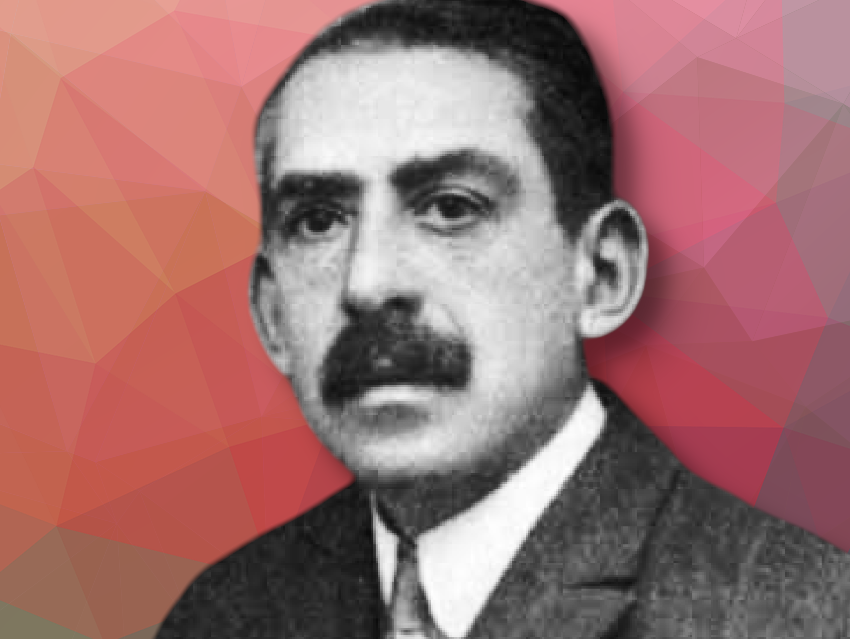Organic Chemist
150 years ago, on July 2, 1875, the German chemist Fritz Ullmann was born in Fürth near Nürnberg. He started studying chemistry in Nürnberg and accomplished his advanced studies in Switzerland (Geneva) where he received his Ph.D. for work with Carl Gräbe (1841–1927) in 1895. An outcome of their fruitful cooperation was a new synthesis of carbazoles, named Graebe-Ullmann synthesis after them (see Fig. 1). Another outcome of Fritz Ullmann`s first years in Geneva is his introduction of dimethyl sulfate as an alkylating agent.
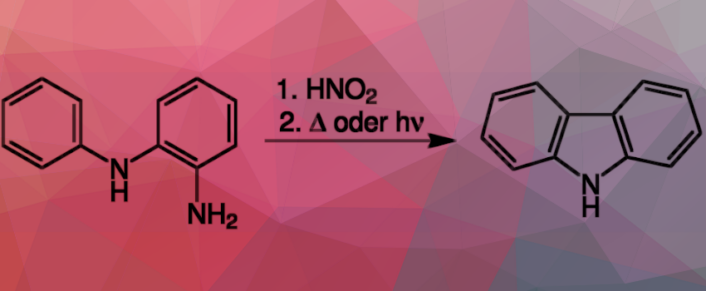
Figure 1. Graebe-Ullmann synthesis for the production of carbazoles.
It was also in Geneva where he met his later wife Irma Goldberg, a chemistry student from Russia. They worked together in Geneva and published famous name reactions, all dealing with the copper-catalyzed conversion of aromatic halides and amines. These include the Ullmann reaction, i.e., copper-catalyzed coupling of aromatic halides with nucleophiles (see Fig. 2), the Goldberg reaction, i.e., copper-catalyzed reaction between aryl halides and aromatic amines or amides, and the Ullmann condensation, i.e., the copper-promoted conversion of aryl halides to aryl ethers, aryl thioethers, aryl nitriles, and aryl amines).
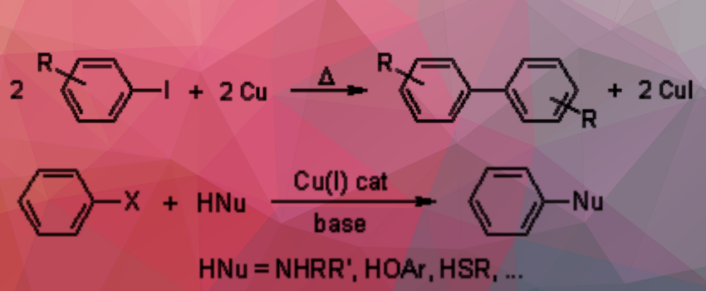
Figure 2. The “classic” Ullmann Reaction is the synthesis of symmetric biaryls via copper-catalyzed coupling. The “Ullmann-type” Reactions include copper-catalyzed nucleophilic aromatic substitution between various nucleophiles with aryl halides
After some time in Geneva, he and Irma Goldberg moved to Berlin, Germany, in 1905, where they got married in 1910. Ullmann and Goldberg were involved in the development of synthetic dyes, e.g., synthetic alizarin. Ullmann taught technical chemistry from 1905 to 1925 at the Technische Hochschule Berlin (now Technische Universität Berlin), first as part of the ordinary teaching staff, and later as a professor.
We owe him several widely used and productive synthetic methods, whose origin is now scarcely remembered. Foremost among them is the introduction of dimethyl sulfate as an alkylating agent.
—Kurt H. Meyer, 1939
Invitation to Create an Encyclopedia of Technical Chemistry
In Berlin Fritz Ullmann was invited by the publisher Urban und Schwarzenberg to design and edit an encyclopedia of industrial chemistry. Ullmann invited colleagues specialized in various fields of industry to contribute and published the first edition of the “Enzyklopädie der Technischen Chemie” in 12 volumes, the first volumes appearing in 1914 (see Fig. 3).
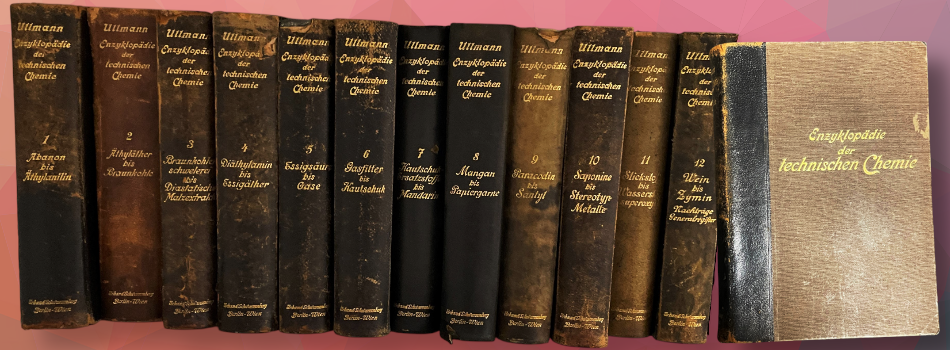
Figure 3. First Edition of the Ullmann’s Ecyclopedia of Industrial Chemistry; 12 volumes published from 1914 to 1923.
Thus, after nearly two years of intensive preliminary work, the basic plan for the entire project was designed, determining both the organization and the scope of the individual articles to be included. The subject of this comprehensive work encompasses not only the chemical industry and metallurgy, along with their mechanical and apparatus-based tools, but also numerous interdisciplinary fields concerned with material transformation and refinement.
Accordingly, it also serves as a kind of materials compendium, covering mining products, metals, chemicals, pharmaceutical preparations and specialties, foodstuffs, drugs, and other substances processed by technical methods. The primary goal of the work is to provide a clear and accurate depiction of current industrial practices. To achieve this, it was deemed necessary to discuss various widely used processes—such as evaporation, distillation, acylation, and reduction—under their respective keywords.
For the same reason, articles of a purely scientific nature were also included, particularly to explain physical, chemical, and physico-chemical concepts and methods in accordance with the current state of scientific knowledge.
—Fritz Ullmann, 1914
This first edition was so much appreciated that from 1928 to 1932 Fritz Ullmann published a second edition with Urban and Schwarzenberg now from Geneva, where he and Irma Goldberg moved to in 1923. The encycloedia hat 11 volumes. Fritz Ullmann felt so much at home in Geneva that he acquired the citizenship of the city. The 2nd edition was so successful that it was reprinted.
Unfortunately, Ullmann could not devise a third edition. He passed away after a serious illness at 64 years old in Geneva on March 17, 1939. The last sign of Irma Goldberg is the signature under Ullmann’s obituary in a local newspaper. It is not clear what happened to her afterward.
Great Internationl Success of the Ullmann’s Encyclopedia
Advisory Board and Editorial Office
The third edition of the encyclopedia, published between 1951 and 1969, encompassed 19 volumes and was even more successful. In the 1950s carbon gasification plants in Germany were reconstructed by chemical engineers using the knowledge of experienced workmen and the details described in the 3rd edition!
For the 3rd edition, an advisory board was introduced, consisting of 17 distinguished chemists from industry and academia, with Dr. Wilhelm Forst as chairman and Dr. Hertha Buchholz-Meisenheimer as editor-in-chief.
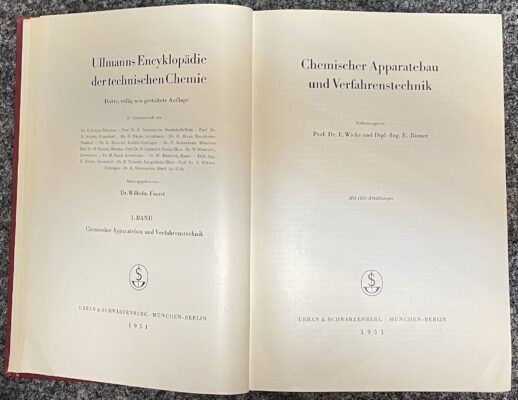
Figure 4. First pages of the first volume of the 3rd edition of Ullmann’s.
New Publisher
In 1970 “Der Ullmann” was sold to Verlag Chemie (now Wiley-VCH) in Weinheim, Germany. Verlag Chemie made sure that also the impressive editor-in-chief Hertha Buchholz-Meisenheimer, the daughter of the famous chemist Jakob Meisenheimer (1876–1934 ), accepted the new job in Weinheim.
This small, energetic person formed and designed the 4th edition of the encyclopedia and embellished the editorial office with the beautiful writing desk of her father. The Ullmann was divided into 18 alphabetical and six basic knowledge volumes, dealing with fundamental knowledge of industrial chemistry, analytics and measuring methods, environmental protection and occupational safety.
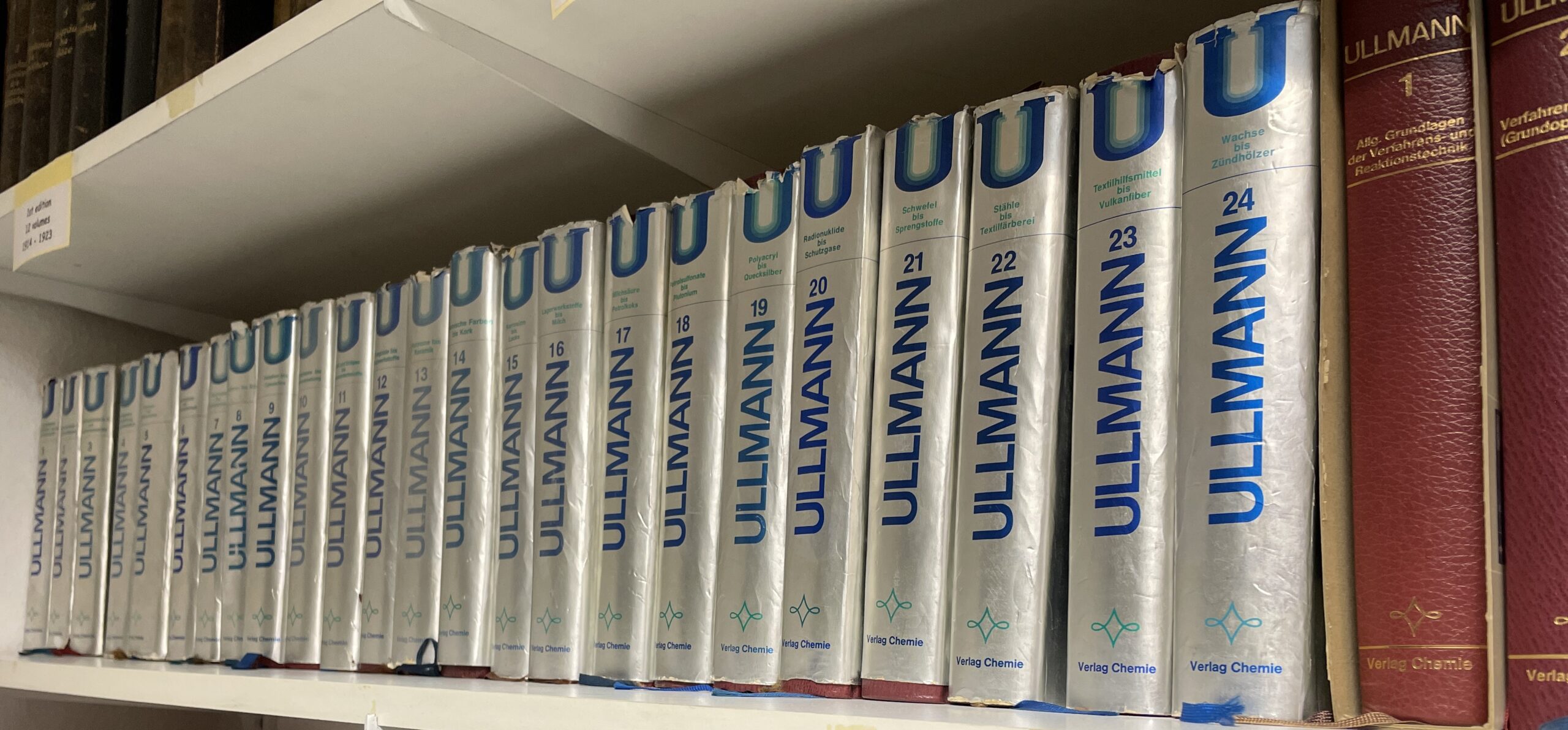
Figure 5. 4th Edition of the Ullmann’s.
During the publication of the last volumes of the 4th edition, the publishers decided to publish the encyclopedia in English starting from the 5th edition, the new name being Ullmann’s Encyclopedia of Industrial Chemistry. Now an international editorial board was established and authors from international companies contracted. The first volume in English appeared in 1985, the last three volumes in 1996, the entire edition encompassing eight basic knowledge and 28 alphabetical volumes.
From Print to Online
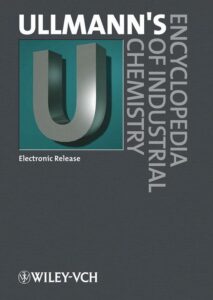 In the mid-1990s the publication of Ullmann’s in electronic form was prepared, from 1997 onward the total content of the Ullmann was published electronically on CD, with annual updates (6th edition). This resulted in a totally different workflow for the editorial staff. During the first five editions, the entire contents had to be updated/revised for every new edition in alphabetical order. Now keywords were revised when new developments/processes became industrially important. New keywords and contributions could be easily integrated into the CD of the following year.
In the mid-1990s the publication of Ullmann’s in electronic form was prepared, from 1997 onward the total content of the Ullmann was published electronically on CD, with annual updates (6th edition). This resulted in a totally different workflow for the editorial staff. During the first five editions, the entire contents had to be updated/revised for every new edition in alphabetical order. Now keywords were revised when new developments/processes became industrially important. New keywords and contributions could be easily integrated into the CD of the following year.
Due to the huge data volume the content was published on DVD after several years, followed by Ullmann’s Online with bimonthly updates. Ullmann’s, now in its 7th edition, can be accessed online and is still the benchmark reference in chemistry and chemical and life science engineering. Fritz Ullmann would be proud!
Sources
- Ezyklopädie der technischen Chemie (Ed. Fritz Ullmann), Urban und Schwarzenberg, Berlin, Germany, 1914–1923.
- Barbara Elvers, 100 Jahre „Ullmann“, Chem. Ing. Technol. 2014, 86(12), 2019–2021. https://doi.org/10.1002/cite.201400167
- Kurt H. Meyer, Obituary: Fritz Ullmann 1875-1939, Helvetica Chimica Acta 1940, 23(1), 93–100. https://doi.org/10.1002/hlca.19400230110
- Ullmann’s Encyclopedia of Industrial Chemistry, 7th ed., Wiley-VCH, Weinheim,Germany, 2000.
Fritz Ullmann is the answer to Guess the Chemist (162)
Also of Interest
- Advisory Board & Editorial Office of the online Ullmann’s Encyclopedia of Industrial Chemistry
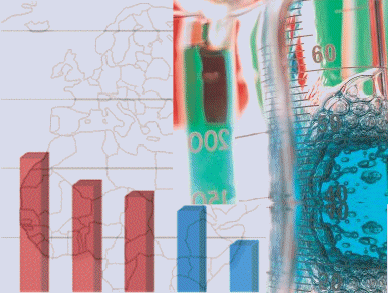
100 years ago, Fritz Ullmann started to discuss topics related to industrial chemistry, the third edition covered the state-of-the art of the 1950s
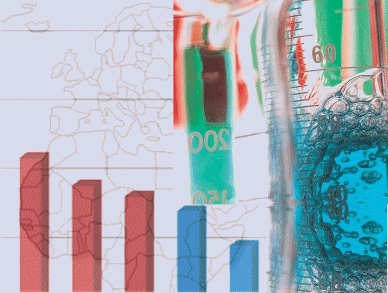
100 years ago, Fritz Ullmann started to discuss topics related to industrial chemistry, the second edition covered the state-of-the art of the 1930s
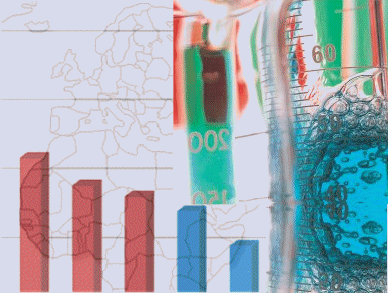
100 years ago, Fritz Ullmann started to discuss topics related to industrial chemistry: state-of-the art of the 1910s

Barbara Elvers, Editor-in-Chief of the Ullmann’s Encyclopedia, talks about her involvement with the Ullmann’s
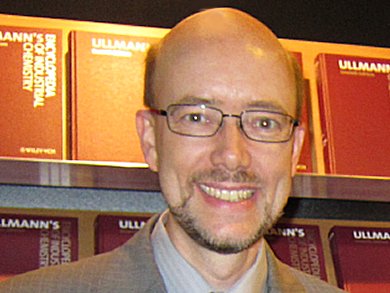
Kai Sundmacher talks about his involvement with Ullmann’s Encyclopedia, bioscientific principles in chemical engineering, multi scale consideration

Michael Röper talks about his involvement with Ullmann’s Encyclopedia throughout the years and what he enjoys most about his career
